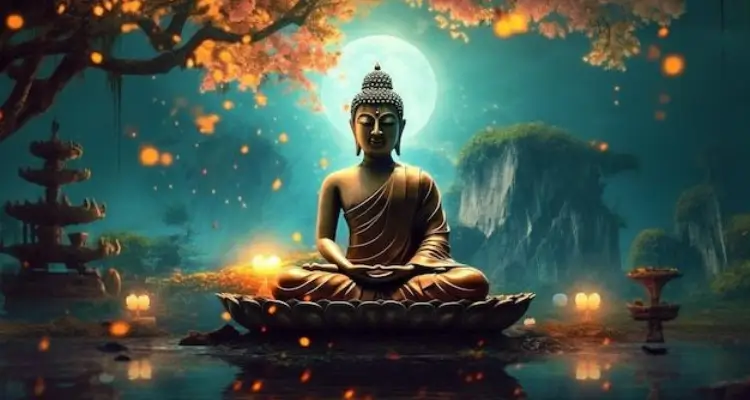Anxiety has become one of the most prevalent emotions in modern society. In a world filled with daily challenges, social pressures, and a fast-paced lifestyle, it is common for many people to feel overwhelmed and anxious. Whether due to concerns about the future, personal insecurities, or the desire for control, anxiety can negatively affect the quality of life, mental health, and overall well-being. While there are various approaches to dealing with this feeling, one of the most profound and transformative perspectives comes from Buddhism.
Buddhism, with its ancient philosophy, offers a unique way of understanding and addressing human emotions, including anxiety. For Buddhists, anxiety is not merely a symptom of external factors but is deeply rooted in our perception of reality and our attachments. Instead of treating anxiety as something to be fought against, Buddhism proposes a more holistic and introspective approach, inviting us to look within and understand the causes of this suffering.
In this article, our goal is to explore how Buddhism approaches anxiety, identifying its fundamental causes and offering practices that can help manage it in a healthy and effective way. We will examine key Buddhist concepts such as impermanence, attachment, and ignorance, and how they are closely linked to our experience of anxiety. By understanding these teachings, we can apply practical solutions to reduce emotional suffering and cultivate a calmer, more balanced mind.
Throughout this article, we hope you gain a new perspective on anxiety and how Buddhist teachings can be a powerful tool for dealing with it. Through practices such as meditation, mindfulness, and self-awareness, it is possible to develop a new relationship with emotions and face life’s challenges with more serenity and wisdom.
What is Anxiety in the Buddhist Context?
In Buddhism, anxiety is not merely seen as a reaction to external factors but rather as a reflection of how our mind interprets and responds to those factors. According to Buddhist philosophy, anxiety is a form of suffering (dukkha) that arises due to our distorted perception of reality and our tendency to cling to things that are temporary and unstable. This suffering is not limited to moments of fear or worry but can manifest in more subtle ways in our daily lives.
The concept of dukkha, which literally translates to “suffering” or “unsatisfactoriness,” is central in Buddhism. It does not only refer to physical pain but also to the dissatisfaction that arises from our constant search for pleasure, security, and control. Anxiety, in this context, is an expression of this suffering because it arises from our inability to accept the impermanence of life and our resistance to face reality as it is. When we cling to unrealistic expectations or try to control the uncontrollable, anxiety emerges as a natural consequence of this attachment.
Furthermore, Buddhism teaches that our mind plays a significant role in creating anxiety. The way we think and interpret reality directly influences our emotional state. Anxious thoughts are often fueled by fears, insecurities, and desires for control, creating a vicious cycle of constant worry. Buddhism teaches us to observe our mind and thoughts without judgment, recognizing that they are not reality but merely temporary manifestations that can be transformed.
Therefore, anxiety is not seen as something external or something that simply happens to us. It is a consequence of how we interact with the world and our own minds. Buddhism offers paths to understand the deep-rooted causes of anxiety and, through practices like meditation, mindfulness, and detachment, overcome it.
The Causes of Anxiety in Buddhism
In Buddhism, anxiety is not merely viewed as an isolated emotion or psychological disorder but as a reflection of our beliefs, perceptions, and attachments. For Buddhists, the root of suffering, including anxiety, is tied to the way we see the world and how we handle the impermanence of life. Buddhism offers a deep understanding of the causes of anxiety, addressing three central concepts: attachment, impermanence, and ignorance.
Attachments and Desires
Attachment is one of the primary causes of suffering in Buddhism. We become attached to objects, people, and specific outcomes, believing that our happiness depends on them. When things don’t go as expected or when the objects or people we are attached to disappear, anxiety arises. The constant desire to control situations, or the relentless pursuit of things we think will bring us happiness, creates a cycle of frustrated expectations, leading to more suffering. True freedom and serenity, according to Buddhist teachings, come from detachment and acceptance of the present moment without being trapped by expectations.
Impermanence (Anicca)
Impermanence is a central concept in Buddhism, teaching that all things are transient and in constant flux. However, we often resist this reality and wish for things to stay stable and unchanging. This resistance to impermanence is one of the greatest sources of anxiety. When we try to control or hold onto something that will inevitably change, we create unnecessary suffering. By understanding and accepting that everything is temporary, we can cultivate a calmer mind and reduce anxiety, as we learn to flow with the changes in life.
Ignorance (Avidyā)
Ignorance, or “Avidyā,” refers to a lack of deep understanding of the true nature of things. In the context of anxiety, ignorance manifests when we fail to understand the interconnectedness of all phenomena and the impermanent nature of life. Often, we worry about things that, in reality, are illusory or unnecessary. Anxiety arises when we don’t recognize that our concerns and fears are based on distorted perceptions of reality. Buddhism teaches that by cultivating wisdom and self-awareness, we can dispel this ignorance and, in turn, reduce anxiety.
The Role of Ego and Identity in Anxiety
In Buddhism, the ego is considered one of the main sources of suffering, including anxiety. The ego is our perception of who we think we are, often built from our desires, fears, past experiences, and attachments. It leads us to believe that we are separate, isolated, and permanent entities, causing us to constantly seek external validation and security. This relentless search for a stable and recognized identity creates a sense of ongoing insecurity, which is one of the roots of anxiety.
Anxiety arises when the ego feels threatened, whether by external changes, criticism, or the fear of losing what it considers essential to its identity. However, Buddhism teaches that this identification with the ego is illusory. The “self” we cultivate as a separate and fixed entity is not the true essence of being. Instead, the true nature of being is interconnected, fluid, and impermanent. By clinging to the ego, we create a wall between ourselves and the natural flow of life, generating conflict and suffering.
Buddhism proposes the dissolution of the ego as a path to achieving a more balanced and peaceful state. This does not mean denying individuality, but rather recognizing that our identity is not fixed and that we are constantly changing. Practices like meditation and mindfulness help us observe the ego objectively, without identifying with it, allowing us to free ourselves from its influence. When we realize that we are more than the ego, our anxiety diminishes, as we stop feeling threatened by situations and external expectations.
The practice of disidentifying from the “self” is a central practice in Buddhism and an effective tool for relieving anxiety. By detaching from the idea that we are something fixed and unchanging, we can accept life’s changes and challenges with greater serenity. This practice enables us to face difficulties with a more open mind, without being dominated by insecurities and the need to maintain a stable and controlled identity.
How Buddhism Faces Anxiety
Buddhism offers a deep and practical approach to addressing anxiety, based on three main pillars: mindfulness, meditation, and the acceptance of impermanence. These practices help cultivate a calmer and more focused mind, allowing us to handle life’s challenges in a more balanced and serene way.
The practice of mindfulness is one of the most effective tools in Buddhism for combating anxiety. It teaches us to bring our attention to the present moment, distancing ourselves from negative and anxious thoughts about the future or regrets about the past. When we practice mindfulness, we learn to observe our thoughts and emotions without identifying with them, allowing us to realize the impermanence of anxious feelings. By becoming aware of what is happening in our minds, we can interrupt the cycle of negative thoughts and reduce anxiety.
Meditation is another central practice in Buddhism, known for its effectiveness in reducing anxiety. During meditation, practitioners focus on their breath, mantras, or simply observing their own thoughts. This process helps calm the mind and creates an inner space of peace. Meditation not only relieves immediate stress but also promotes a greater understanding of our mental patterns, allowing us to observe anxiety in a more objective and less reactive way.
The acceptance of impermanence is a fundamental teaching in Buddhism that can greatly help in managing anxiety. In Buddhism, impermanence is seen as an essential characteristic of all things. Nothing is permanent, and everything is in constant change. By embracing this truth, we begin to understand that our fears and anxieties are also temporary. The fear of the future, which often fuels anxiety, can be lessened when we accept that everything is mutable and that challenges, no matter how intense, do not last forever.
Buddhist Practices for Controlling Anxiety
Buddhism offers several practices that can be highly effective in controlling and reducing anxiety. Among them, Zazen meditation, reflection on the nature of reality, and cultivating compassion stand out. These practices aim to bring more inner peace, greater awareness, and a deeper understanding of the mind and its emotions.
Zazen meditation, a form of seated meditation, is a core practice in Zen Buddhism that can be very helpful in controlling anxiety. During Zazen, the practitioner sits in a comfortable posture and focuses on the breath, allowing thoughts to flow without attachment. When anxious thoughts arise, the practice of Zazen teaches to observe these thoughts without identifying with them. This creates a healthy distance between the practitioner and their thoughts, allowing anxiety to be seen with more clarity and less reactivity, making it easier to control feelings of apprehension.
Another important Buddhist practice for controlling anxiety is reflection on the nature of reality, especially the concept of emptiness, or Śūnyatā. Emptiness in Buddhism does not refer to a state of nothingness but rather to the understanding that all phenomena are interdependent and impermanent. Nothing is fixed or permanent, and this includes our thoughts and emotions. By reflecting on emptiness, we realize that anxiety, like any other feeling, is transient and does not have a permanent existence. This view can reduce attachment to anxious thoughts, allowing us to deal with them in a more balanced and detached manner.
Lastly, cultivating compassion is a fundamental practice that can significantly relieve anxiety. In Buddhism, compassion (Karuna) is seen as one of the greatest antidotes to suffering. By practicing compassion for ourselves and others, we create a space of acceptance and understanding, which reduces mental and emotional tension. Compassion helps to release judgment and criticism, which often fuel anxiety, promoting a state of peace and acceptance. By developing compassion, we cultivate a healthier environment for our minds, where anxiety loses its power.
Benefits of Applying Buddhism for Anxiety in Everyday Life
Buddhist philosophy offers a range of powerful tools for dealing with anxiety in a healthy and practical way. By applying Buddhist teachings, we can transform how we react to stressful situations, cultivate a calmer and more balanced mindset, and ultimately reduce the anxiety that often overwhelms us. Buddhism doesn’t offer quick fixes or magic solutions, but simple yet profound practices that help change how we perceive and handle life’s challenges.
One of the key tools Buddhism offers is mindfulness. The practice of mindfulness involves bringing attention to the present moment without judgment. In everyday life, this can be applied in simple ways, such as while eating, walking, or even washing dishes. By practicing mindfulness, we become more aware of our emotions and thoughts, allowing us to recognize when anxiety is arising. This early recognition helps us not to react impulsively but to take a pause, breathe, and refocus on the present, which naturally reduces the impact of anxiety.
Another benefit of Buddhism in managing anxiety is the regular practice of meditation. Buddhist meditation is not limited to moments of introspection at the beginning or end of the day; it can be incorporated throughout the day. For example, when faced with a stressful situation at work or at home, we can pause for a few minutes and do a brief meditation, focusing on the breath or the body. This helps to calm the mind, reduce stress levels, and create space for more balanced and mindful responses, instead of automatic reactions driven by anxiety.
The acceptance of impermanence, one of the central concepts in Buddhism, is also a transformative practice when applied to anxiety. Understanding that all feelings and situations are temporary helps us maintain perspective and not become attached to anxious thoughts or an uncertain future. By practicing the acceptance of impermanence, we learn to live with greater freedom, without the need to control everything around us, which naturally reduces pressure and anxiety.
Incorporating these practices into our daily lives can transform the way we face anxiety, promoting more peace, emotional balance, and, above all, a deeper understanding of ourselves and the world around us.
Conclusion
In this article, we explored how Buddhism understands anxiety and its causes. We saw that, for Buddhism, anxiety is closely linked to attachment, fear of the future, and excessive identification with the ego. The ego, with its insecurities and unrealistic expectations, is one of the primary sources of suffering. Additionally, the concept of impermanence and the need to control situations can further aggravate this anxious state. Practices like mindfulness, meditation, and the acceptance of impermanence are powerful tools Buddhism offers to effectively and healthily face anxiety.
By applying these teachings in daily life, we can learn to observe our thoughts and emotions without attaching to them, live more in the present moment, and accept the impermanence of circumstances. This helps reduce anxiety and achieve a state of inner peace.
Now, we encourage you to apply the Buddhist teachings in your own life. Try incorporating practices like mindfulness and meditation into your daily routine, noticing how they can help you manage anxiety more effectively and healthily.
To get started, how about setting aside a few minutes each day to practice mindfulness or meditation? These practices may be simple, but they have a profound impact. If you want to learn more about how Buddhism can help you better understand your emotions and alleviate suffering, continue exploring the topic. Buddhism offers valuable tools for self-awareness that can transform the way we deal with anxiety and life’s challenges.

































